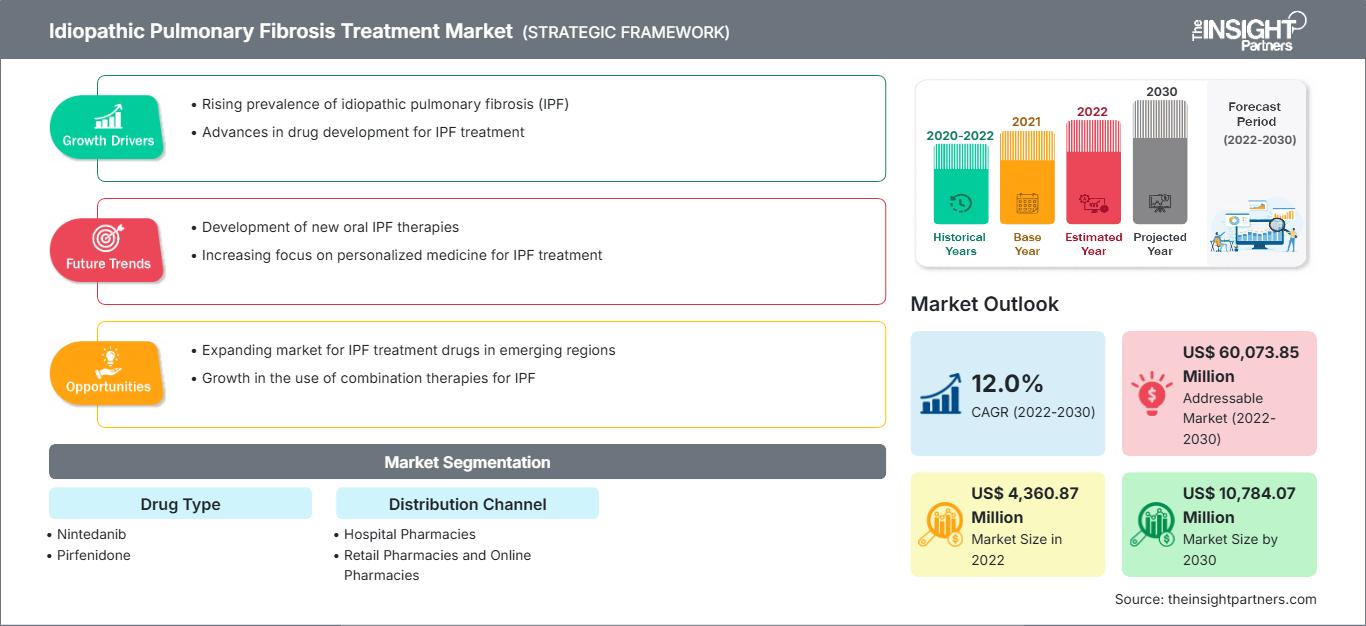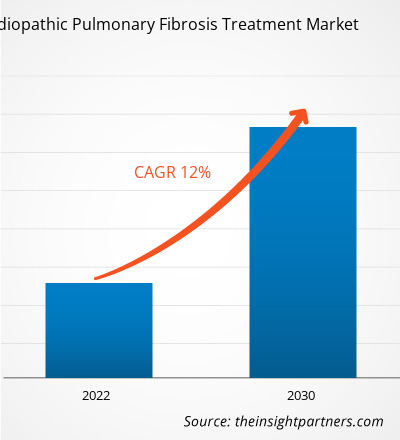[Informe de investigación] Se proyecta que el tamaño del mercado de tratamiento de la fibrosis pulmonar idiopática aumentará de US$ 4.360,87 millones en 2022 a US$ 10.784,07 millones en 2030; se estima que el mercado crecerá a una CAGR del 12,0% durante 2022-2030.
Perspectiva del analista:
La fibrosis pulmonar idiopática es una enfermedad crónica que afecta el tejido que rodea los alvéolos pulmonares. Se desarrolla cuando los tejidos pulmonares se vuelven rígidos y engrosados por razones desconocidas. Estos cambios, con el tiempo, resultan en cicatrices permanentes en los pulmones, lo que dificulta la respiración de los pacientes. Actualmente, no existe una cura precisa para la fibrosis pulmonar idiopática. Tratamientos como la rehabilitación pulmonar, medicamentos y procedimientos quirúrgicos ralentizan el daño pulmonar y ayudan a mejorar la calidad de vida de los pacientes.
La creciente prevalencia de la fibrosis pulmonar idiopática y el creciente número de fumadores impulsarán la demanda de fármacos eficaces para su tratamiento en los próximos años. Es probable que la investigación en curso para introducir fármacos eficaces para el tratamiento de la fibrosis pulmonar idiopática beneficie aún más al mercado en el futuro. Actualmente, el gasto en atención médica ha aumentado tanto en los mercados desarrollados como en los emergentes, lo que se espera que anime a los fabricantes de este mercado a concentrar sus esfuerzos en el desarrollo de productos nuevos e innovadores.
Descripción general del mercado:
La fibrosis es la deposición de tejido conectivo que se produce como parte del proceso normal de curación o la deposición de tejido sobrante que se produce como un proceso patológico. La fibrosis pulmonar idiopática afecta al tejido conectivo de los pulmones y los alvéolos (sacos de aire en los pulmones). Esta afección puede causar dificultad para respirar al realizar tareas rutinarias, que no resultan tediosas para quienes gozan de buena salud. El crecimiento del mercado de tratamiento de la fibrosis pulmonar idiopática se atribuye a la creciente incidencia de enfermedades fibróticas y al aumento del número de fumadores. Se espera que el rápido ritmo de las actividades de investigación y desarrollo, que conduce a avances tecnológicos en los tratamientos, brinde oportunidades de crecimiento para el mercado de tratamiento de la fibrosis pulmonar idiopática en los próximos años.
Obtendrá personalización en cualquier informe, sin cargo, incluidas partes de este informe o análisis a nivel de país, paquete de datos de Excel, así como también grandes ofertas y descuentos para empresas emergentes y universidades.
Mercado de tratamiento de la fibrosis pulmonar idiopática: Perspectivas estratégicas

-
Obtenga las principales tendencias clave del mercado de este informe.Esta muestra GRATUITA incluirá análisis de datos, desde tendencias del mercado hasta estimaciones y pronósticos.
Conductor del mercado:
La creciente carga de fibrosis pulmonar idiopática impulsa el mercado de tratamiento de la fibrosis pulmonar idiopática.
Según datos de la Asociación Americana del Pulmón, actualizados en noviembre de 2022, en EE. UU. se diagnostican aproximadamente 50.000 nuevos casos de fibrosis pulmonar idiopática cada año. Los síntomas de esta afección son más evidentes en pacientes de 50 a 70 años. Según un artículo publicado en el British Medical Journal en septiembre de 2022, la prevalencia estimada de fibrosis pulmonar idiopática en unidades de atención especializada en 2021 fue de 36,0 por 100.000. El número de pacientes con fibrosis pulmonar idiopática está aumentando en todo el mundo debido a factores de riesgo comunes como el envejecimiento, la obesidad, la hipertensión o los antecedentes familiares, y la afección se está convirtiendo en una carga socioeconómica significativa. Por lo tanto, el creciente número de pacientes con fibrosis pulmonar idiopática impulsa el crecimiento del mercado de tratamientos para enfermedades fibróticas. fibrotic disease treatment market growth.
Análisis segmentario: Analysis:
Según el tipo de fármaco, el mercado del tratamiento de la fibrosis pulmonar idiopática se segmenta en nintedanib, pirfenidona y otros. El segmento de nintedanib tuvo una mayor cuota de mercado en 2022. Se prevé que el segmento de otros registre una tasa de crecimiento anual compuesta (TCAC) mayor, del 46,3 %, entre 2022 y 2030. La pirfenidona y el nintedanib son los medicamentos más populares para tratar enfermedades fibróticas.
Análisis regional:
Norteamérica domina el mercado global de tratamiento de la fibrosis pulmonar idiopática. El mercado norteamericano se valoró en 2.362,95 millones de dólares estadounidenses en 2022 y se proyecta que alcance los 5.527,28 millones de dólares estadounidenses para 2030; se espera que registre una tasa de crecimiento anual compuesta (TCAC) del 11,2 % durante el período 2022-2030. El mercado norteamericano de tratamiento de la fibrosis pulmonar idiopática está segmentado en Estados Unidos, Canadá y México. La creciente incidencia de la fibrosis pulmonar idiopática y los avances tecnológicos en los tratamientos benefician a este mercado en Norteamérica. Los lanzamientos de productos y las iniciativas estratégicas de los principales actores del mercado también contribuyen al crecimiento del mercado. Con el creciente número de actividades de investigación y desarrollo para tratar la fibrosis pulmonar idiopática, se están introduciendo mejores fármacos en el mercado, lo que se traduce en un mejor acceso a los medicamentos para un grupo más amplio de pacientes. Además, las numerosas aprobaciones de la FDA en la región incentivan a las empresas a lanzar productos tecnológicamente sofisticados.
Con la creciente prevalencia de la fibrosis pulmonar idiopática y el elevado gasto sanitario, Europa ocupa la segunda posición en el mercado mundial del tratamiento de enfermedades fibróticas. Se prevé que Alemania domine el mercado europeo del tratamiento de la fibrosis pulmonar idiopática gracias a un mejor acceso a productos y servicios tecnológicamente avanzados en el sector sanitario.
Se espera que Asia Pacífico registre la tasa de crecimiento anual compuesta (TCAC) más rápida en el mercado global de tratamiento de la fibrosis pulmonar idiopática durante el período 2022-2030. Este crecimiento proyectado del mercado se debe a la amplia aceptación y adopción de tecnologías de vanguardia que producen resultados precisos en un plazo significativamente menor. Las industrias de la salud de la región están aprovechando las innovaciones en inteligencia artificial, automatización y transformación digital, impulsando la eficiencia y la productividad de los profesionales médicos. La transformación continua en diversas industrias fortalece a las empresas y economías de Asia Pacífico, lo que les permite posicionarse como el centro de mayor desarrollo con un enfoque dinámico y vanguardista hacia el progreso sostenible.
Análisis de los jugadores clave:
El análisis del mercado del tratamiento de la fibrosis pulmonar idiopática se basa en actores clave como Genentech, Inc. y Boehringer Ingelheim International GmbH.
Perspectivas regionales del mercado del tratamiento de la fibrosis pulmonar idiopática
Los analistas de The Insight Partners han explicado detalladamente las tendencias y los factores regionales que influyen en el mercado del tratamiento de la fibrosis pulmonar idiopática durante el período de pronóstico. Esta sección también analiza los segmentos y la geografía del mercado del tratamiento de la fibrosis pulmonar idiopática en América del Norte, Europa, Asia Pacífico, Oriente Medio y África, y América del Sur y Central.
Alcance del informe de mercado sobre el tratamiento de la fibrosis pulmonar idiopática
| Atributo del informe | Detalles |
|---|---|
| Tamaño del mercado en 2022 | US$ 4.360,87 millones |
| Tamaño del mercado en 2030 | US$ 10.784,07 millones |
| CAGR global (2022-2030) | 12.0% |
| Datos históricos | 2020-2022 |
| Período de pronóstico | 2022-2030 |
| Segmentos cubiertos |
Por tipo de fármaco
|
| Regiones y países cubiertos |
América del norte
|
| Líderes del mercado y perfiles de empresas clave |
|
Densidad de actores del mercado del tratamiento de la fibrosis pulmonar idiopática: comprensión de su impacto en la dinámica empresarial
El mercado del tratamiento de la fibrosis pulmonar idiopática está creciendo rápidamente, impulsado por la creciente demanda del usuario final debido a factores como la evolución de las preferencias de los consumidores, los avances tecnológicos y un mayor conocimiento de los beneficios del producto. A medida que aumenta la demanda, las empresas amplían su oferta, innovan para satisfacer las necesidades de los consumidores y aprovechan las tendencias emergentes, lo que impulsa aún más el crecimiento del mercado.

- Obtenga una descripción general de los principales actores clave del mercado de tratamiento de la fibrosis pulmonar idiopática.
Desarrollos recientes:
Las estrategias inorgánicas y orgánicas, como las fusiones y adquisiciones, son ampliamente adoptadas por las empresas del mercado del tratamiento de la fibrosis pulmonar idiopática. A continuación, se enumeran algunos desarrollos recientes:
- En mayo de 2023, Boehringer Ingelheim inició el desarrollo clínico de BI 765423, un innovador anticuerpo inhibidor de IL-11. El estudio de fase 1 (NCT05658107) se centró en evaluar su seguridad, tolerabilidad y farmacocinética en voluntarios sanos. Los estudios preclínicos han mostrado resultados prometedores de este fármaco anti-IL-11 en la inhibición y posible reversión de la fibrosis en diversos casos fibróticos.
- En octubre de 2022, Boehringer Ingelheim inscribió al primer paciente estadounidense en el estudio de fase III FIBRONEER-IPF, que evalúa BI 1015550. BI 1015550 es un inhibidor experimental de la fosfodiesterasa 4B (PDE4B) descubierto para el tratamiento de personas con fibrosis pulmonar idiopática. El estudio forma parte del programa global FIBRONEER, que incluye dos estudios de fase III: FIBRONEER-IPF en pacientes con fibrosis pulmonar idiopática y FIBRONEER-ILD en adultos con otras enfermedades pulmonares intersticiales fibrosantes progresivas (ILD).
- En septiembre de 2022, Bellerophon Therapeutics, Inc. anunció que la FDA aceptó la solicitud de reducción del tamaño del ensayo para su actual ensayo de registro de fase 3 REBUILD de INOpulse, indicado para el tratamiento de la enfermedad pulmonar intersticial fibrótica (LD).
- En mayo de 2022, ArisGlobal, líder mundial en soluciones de seguridad farmacológica, adquirió la innovación digital BRASS de Boehringer Ingelheim. Esta adquisición le permitió optimizar su plataforma tecnológica LifeSphere al integrar BRASS en LifeSphere Clarity. Esta integración ha contribuido al avance de la farmacovigilancia y la seguridad del paciente en toda la industria. Además, ArisGlobal ha ampliado su presencia en el negocio de diagnóstico clínico en diversas regiones del mundo, consolidando su posición global.
- En marzo de 2022, Bristol Myers Squibb, compañía farmacéutica líder, anunció la adquisición de Turning Point Therapeutics, Inc. por US$ 76,00 por acción mediante un acuerdo definitivo de fusión. Esta adquisición ha fortalecido significativamente la presencia global de Bristol Myers Squibb en el mercado farmacéutico, permitiéndole ser más proactiva en la innovación de la industria, a la vez que amplía su cartera de terapias y tratamientos vitales.
- Análisis histórico (2 años), año base, pronóstico (7 años) con CAGR
- Análisis PEST y FODA
- Tamaño del mercado, valor/volumen: global, regional y nacional
- Industria y panorama competitivo
- Conjunto de datos de Excel
Informes recientes
Testimonios
Razón para comprar
- Toma de decisiones informada
- Comprensión de la dinámica del mercado
- Análisis competitivo
- Información sobre clientes
- Pronósticos del mercado
- Mitigación de riesgos
- Planificación estratégica
- Justificación de la inversión
- Identificación de mercados emergentes
- Mejora de las estrategias de marketing
- Impulso de la eficiencia operativa
- Alineación con las tendencias regulatorias






















 Obtenga una muestra gratuita para - Mercado de tratamiento de la fibrosis pulmonar idiopática
Obtenga una muestra gratuita para - Mercado de tratamiento de la fibrosis pulmonar idiopática